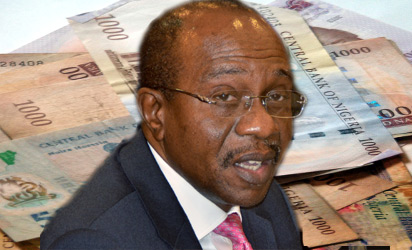As dollar inflow into I&E falls by 42%
CBN defends naira in I&E with $4.35bn in 3mths
By Babajide Komolafe
WITH dollar inflow into the Investors and Exporters window, I&E, falling by 42 percent in October, and the external reserves maintaining its downward trend, losing another $2.639 billion since the last meeting of the Monetary Policy Committee, MPC, of the Central Bank of Nigeria, CBN, in September, economic analysts have projected that the committee, at the end of its meeting this week, will maintain its policy rates in deference to the need to sustain dollar inflow from foreign portfolio investors in the nation’s debt market with a view to forestall the declining trend in the reserves and demand pressure in the nation’s foreign exchange market.
At the end of its meeting in September, the MPC maintained all its policy rates, retaining the Monetary Policy Rate, MPR, at 14 percent, with the asymmetric corridor at +200 and -500 basis points around the MPR. It retained the Cash Reserve Ratio, CRR, and Liquidity Ratio, LR, at 22.50 percent and 30 percent respectively. Among other things the committee’s decision was influenced by rising inflation and declining external reserves due to exit of foreign investors from the financial markets.

“The Committee identified rising inflation and pressure on external reserves created by capital flow reversal as the current challenges to growth. It noted that inflationary pressures have started rebuilding and capital flow reversals have intensified as shown by the bearish trend in the equities market even though the exchange rate remains very stable”, said CBN Governor, Mr. Godwin Emefiele at the post MPC meeting media briefing.
Analysts opined that the same factors, namely rising inflation which rose for the second consecutive months to 11.28 percent in September, and is projected to have risen further in October, as well as capital flow reversal, will dominate the considerations at the MPC meeting this week. They, however, noted that the MPC notwithstanding will not commence a tightening stance by raising the MPR but will wait till next year.
According to analysts at FSDH Merchant Bank, “Rising demand for foreign exchange leading to a consistent decline in the foreign reserves, and rising inflation rate are major justifications for an increase in policy rates.
Nigeria among top 5 nations in global $613 b remittances – CBN
Increase in policy rates
However, FSDH Research believes members of the Monetary Policy Committee, MPC, of the Central Bank of Nigeria, CBN, may decide to delay an increase in the monetary policy rate until their January 2019 meeting.”
Similarly, analysts at Cowry Asset Management Limited stated: “Meanwhile, ahead of the 264th Monetary Policy Committee meeting scheduled for Monday and Tuesday, November 19 and 20, 2018, we expect the MPC to retain the MPR at 14 percent, within the existing corridor of +2 percent and -5 percent. This is against the backdrop of 11.28 percent rise in September inflation and the need to maintain positive real interest rates in order to slowdown the dwindling external reserves and attract portfolio inflows, which have largely reversed in recent times amid increase in the US Fed rate.”
CBN defends naira with $4.35bn in I&E in three months
Meanwhile, the Financial Vanguard analysis revealed that the CBN injected $4.35 billion into the Investors and Exporters window in three months in order to defend the naira in the window. Analysis revealed that the I&E window recorded inflow of $8.79 billion in three months from August to October, with the CBN injection accounting for 49 percent of the inflow.
Inflow from foreign portfolio investors came second with $1.85 billion representing 21 percent of total inflow. Further analysis revealed that while dollar inflow into the window rose by 14 percent to $3.58 billion in September from $3.13 billion in August, the inflow however fell by 42 percent to $2.08 billion in October. Although inflow from foreign portfolio investors rose by 42 percent to $780 million in September from $550 million in August, it however fell by 33.3 percent to $520 million in October.
Similarly, CBN injection into the window rose by 41 percent to $2.02 billion in September from $1.43 billion in August, but fell by 55 percent to $900 million in October.
Analysis, however, revealed that the ratio of FPI inflow rose steadily during the three months period. From 17.46 percent in August, it rose to 21.94 percent in September, and again to 25.18 percent in October.
On the hand, while CBN injection accounted for 45.78 percent of total inflow in August, it rose to 56.4 percent in September but fell to 43.07 percent.
Naira depreciates as External reserves decline slows
In spite of the efforts of the CBN to defend the naira, the naira depreciated last week in both the parallel market and in the I&E window. In the parallel market the naira depreciated by N1 as the market exchange rate rose to N361.5 per dollar on Friday from N360.5 the previous week.
In the I&E window the naira depreciated by 41 kobo as the indicative exchange rate rose to N364.01 per dollar from N363.6 per dollar the previous week. The depreciation according to analysts at Cowry Assets Management Limited is triggered by increased dollar demand amidst falling external reserves. However, data from the CBN showed further slowdown in the week-on-week (w/w) decline in external reserves.
The reserves fell to $41.620 billion last week Thursday from $41.756 billion on Thursday of the previous week. This translates to a w/w decline of $136 million, which is 28 percent lower than the $190 million w/w decline recorded the previous week.
Source: https://www.vanguardngr.com/2018/11/mpc-to-maintain-rates-to-sustain-foreign-portfolio-inflows/


